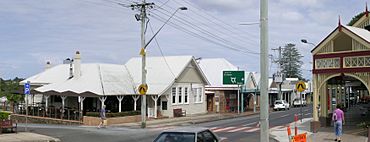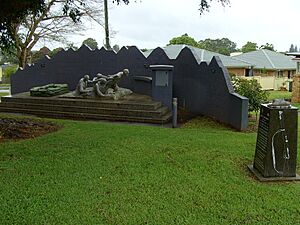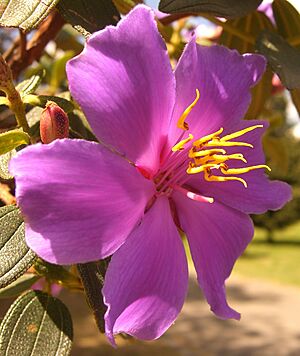Alstonville, New South Wales facts for kids
Quick facts for kids AlstonvilleNew South Wales |
|||||||||
|---|---|---|---|---|---|---|---|---|---|

Main Street
|
|||||||||
| Population | 5,182 (2021 census) | ||||||||
| Postcode(s) | 2477 | ||||||||
| Elevation | 140 m (459 ft) | ||||||||
| Time zone | AEST (UTC+10) | ||||||||
| • Summer (DST) | AEDT (UTC+11) | ||||||||
| Location | |||||||||
| LGA(s) | Ballina Shire | ||||||||
| State electorate(s) | Ballina | ||||||||
| Federal Division(s) | Page | ||||||||
|
|||||||||
Alstonville is a friendly town in northern New South Wales, Australia. It's part of a beautiful area called the Northern Rivers. You can find Alstonville on the Bruxner Highway. It's about 13 kilometers east of Ballina and 19 kilometers west of Lismore. The small village of Wollongbar is just 4 kilometers west. Alstonville is like the main hub for the area known as the Alstonville Plateau.
The original people of this land are the Bundjalung people. They have lived here for a very long time.
Contents
- Alstonville's Past: A Glimpse into History
- Alstonville's Growing Population
- Town Facilities and Services
- Local Economy and Businesses
- Schools in Alstonville
- Getting Around: Transport in Alstonville
- Sports and Recreation on the Plateau
- Cool Facts About Alstonville
- Local Media
- Famous People From Alstonville
Alstonville's Past: A Glimpse into History
European settlers first came to this area in the 1840s. They were looking for valuable red cedar trees. This region was once a huge rainforest called the "Big Scrub."
The first settlers officially claimed land in 1865. This area was then known as the parish of Tuckombil. Families like the Freeborn, Roberston, and Graham families were among the first. By 1883, Alstonville was growing fast. It had two pubs, six stores, and many mills.
Early Industries and Farming
Growing sugar cane was very important for the early settlers. Many small mills processed the cane. Later, bigger and better steam mills were built. One was in Alstonville in 1882. Another was at Rous Mill. By 1896, the Rous mill even had a small train line to carry cane from Alstonville.
From the 1890s, dairy farming became popular. It was the main industry for the first half of the 1900s. Because there were no refrigerators, farmers made cream instead of milk. This cream was taken to local factories to be made into butter. The Alstonville butter factory opened in 1900. It later became a caravan factory, then a peanut factory, and now a furniture factory.
A Local Hero: Patrick Joseph Bugden
One famous person from Alstonville was Patrick Joseph Bugden. He was a brave soldier who fought in World War I. He received the Victoria Cross. This is the highest award for bravery in the Commonwealth armed forces.
"Paddy" Bugden was part of the 31st Battalion. The yearly Anzac Day parade starts at his memorial. This memorial is on Bugden Avenue.
How Alstonville Got Its Name
The village was first called "Duck Creek Mountain." This name came from Duck Creek, which flows nearby. Cedar cutters gave it this name because of all the wild ducks there.
In 1873, the name was changed. The first postmaster, John Perry, suggested "Alstonville." This was the name of his farm. It came from his wife Annie Alston's maiden name.
Alstonville's Growing Population
| Historical population | ||
|---|---|---|
| Year | Pop. | ±% |
| 1966 | 576 | — |
| 1971 | 779 | +35.2% |
| 1976 | 1,457 | +87.0% |
| 1981 | 2,936 | +101.5% |
| 1986 | 3,266 | +11.2% |
| 1991 | 3,678 | +12.6% |
| 1996 | 4,725 | +28.5% |
| 2001 | 4,751 | +0.6% |
| 2006 | 5,006 | +5.4% |
| 2011 | 4,990 | −0.3% |
| 2016 | 5,066 | +1.5% |
| 2021 | 5,182 | +2.3% |
| Source: Australian Bureau of Statistics data. | ||
In 2021, about 5,182 people lived in Alstonville. Most people, 84.3%, were born in Australia. The next largest group, 4.2%, were born in England.
Almost everyone, 92.1%, spoke only English at home. When asked about religion, 39.9% said they had no religion. About 18.7% were Catholic, and 14.9% were Anglican.
Town Facilities and Services
Alstonville has some interesting places. Crawford House is an old pioneer house. It is now a historical museum. It's next to Elizabeth Ann Brown Park.
Right behind the museum is Alstonville Plaza. This is the town's main shopping center. It has a big supermarket and other shops. Alstonville has a post office, but no banks anymore.
Summerland Farm: A Special Place
Summerland Farm has been operating near Alstonville since 1971. It helps people with disabilities. It gives them training and jobs in farming and hospitality. Over 100 people work there.
Summerland Farm is a popular tourist spot. It's also a working avocado and macadamia farm. It helps distribute produce from other farms too. It's one of the oldest and most successful businesses in the region.
Alstonville also has its own emergency services. These include Fire & Rescue NSW and NSW Police.
Local Economy and Businesses
Alstonville has an industrial area called Russleton Park. Here you'll find businesses that work with cement. There are also places that process macadamia nuts. Other businesses sell rural supplies.
Many bus depots are located here. There is also a mail sorting center. This industrial area is across the highway from Wollongbar. However, it is not part of Wollongbar.
Schools in Alstonville
Alstonville is home to three schools. There are two public schools and one private school.
- Alstonville Public School is a state primary school.
- St Joseph's School is a Catholic primary school.
- Alstonville High School is a state secondary school.
A new Alstonville Preschool opened in 2016. It is next to the Olympic Swimming Pool.
Getting Around: Transport in Alstonville
You can travel between Alstonville and Wollongbar by car. There is also a path for walking or biking. This path connects Bulwinkel Park and the Wollongbar shopping center.
Bus services in Alstonville are limited. There are no buses at night or on weekends.
Improving Transport: The Bypass
Traffic in Alstonville used to get very busy. This was because the main road went right through the town. It was the main route between Lismore and Ballina.
A special bypass road has been built for the Bruxner Highway. This helps reduce traffic jams and makes the roads safer. All three schools are in a busy area. This caused parking problems for students and parents. The bypass helps with this issue.
Sports and Recreation on the Plateau
Alstonville has many parks for sports. Geoff Watt Oval is a major sports ground. People play cricket and soccer there. Crawford Park is another soccer ground across the highway.
- The Alstonville and District Football Club is the local soccer club. They are known as "Villa" and wear red and black uniforms.
- Wollongbar Alstonville Pioneers Rugby (WAR) is the local Rugby Union club. It is located in Wollongbar.
- Alstonville & District Cricket Club is Alstonville's only cricket team. They play in the LJ Hooker League each year. Their games are held at Geoff Watt Oval, Hill Park Oval, and Gap Road.
- Alstonville is also home to FNC NSW Futsal. This is played at the Alstonville Entertainment Centre.
Cool Facts About Alstonville
Did you know about the Andesanthus lepidotus 'Alstonville' plant? It's a small tree with beautiful purple flowers in autumn. This special type of plant was created by Ken Dunstan. He was a resident of Alstonville, which is why it's named after the town!
The world's first commercial farm for macadamia trees was planted nearby. Charles Staff planted it in the early 1880s. It was at Rous Mill, about 7 kilometers southwest of Alstonville.
Local Media
Alstonville has a Christian radio station on FM 88.0 MHz. You can also listen to nearby local stations. These include 101.9 Paradise FM from Ballina and 100.9 ZZZ FM from Lismore.
Famous People From Alstonville
- Rachael Beck, an actress
- Doug Daley, a rugby league player and administrator
- Nicholas Hamilton, an actor
- Russell Strong, a surgeon
- Brendan Drew, a cricketer




